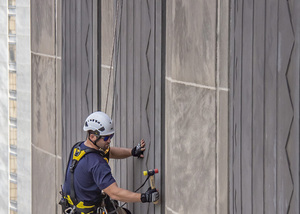 Inspections conducted by rope access can be less intrusive and less expensive, as well as more efficient and thorough than traditional scaffold-drop inspections.
Inspections conducted by rope access can be less intrusive and less expensive, as well as more efficient and thorough than traditional scaffold-drop inspections.
RAND's Rope Access Facade Inspection Team
As part of RAND’s Facade Inspection Safety Program (FISP) services, RAND has a team of certified Professional Rope Access Technicians who conduct hands-on facade inspections more efficiently and less expensively than traditional scaffold-drop inspections from a motorized rig.
Required Hands-on Inspections
FISP, formerly known as New York City Local Law 11/98, requires the facades of buildings taller than six stories to be inspected by a licensed engineer or architect every five years. A facade inspection report must then be filed with the city listing the building as Safe, Safe With a Repair and Maintenance Program (SWARMP), or Unsafe. Under FISP, the engineer/architect must conduct a hands-on inspection along at least one of the building’s street-facing facades. Additional hands-on inspections may be required if deemed necessary by the engineer/architect for a definitive evaluation.
Motorized Scaffold Drops
The engineer/architect typically conducts the hands-on inspection from a motorized scaffold hung from the roof. Scaffold drop inspections require a day to set up the motorized rig, with the facade inspection itself typically taking place the following day.
Faster Mobilization with Rope Access
Because it doesn’t require beams, platforms, and counterweights as motorized rigs do, rope access can be set up in only a few hours, and the inspection conducted the same day. Ropes and other rappelling equipment can also be quickly and easily disassembled, moved to another facade, and set up again.
Less Intrusive Installation
Conducting hands-on facade inspections via rope access is the preferred option in cases where operating a motorized scaffold is not feasible, such as on buildings with sloped roofs, closely spaced terraces, or angled facades. In addition, many building owners do not want scaffolding equipment mounted on the facades because residents find it intrusive or because it blocks views, or for other aesthetic and/or security reasons.
More Thorough Inspections
Rope access inspectors can move freely to cover wider areas of the facades and conduct more extensive inspections. Performing inspections via rope access enables inspectors to more fully determine the extent and locations of repairs, resulting in more accurate scopes of work and budget projections.
Cost Savings
Because of quicker mobilization, easier set-up, and fewer equipment requirements for rope access inspections, contractor costs can be less expensive than inspections from a motorized rig, particularly when two or more drops are required. The savings can increase when multiple facades on the building require hands-on inspection.
Certified Facade Inspectors
RAND is authorized by the New York City Department of Buildings to perform inspections by industrial rope access, and our inspectors are certified by the Society of Professional Rope Access Technicians. (The DOB makes the final decision regarding which buildings are suitable for rope access.)
Rope access is a commonly used and widely accepted method for inspecting facades, and it has an extensive record for safety. RAND’s team of certified rope access technicians performs inspections in accordance with SPRAT and American Society for Testing and Materials (ASTM) safety guidelines and standards.
More Information
To find out if your building would benefit from a FISP inspection using rope access, please contact RAND at 212-675-8844; info@randpc.com.
See our Rope Access Team in action in this photo essay.
